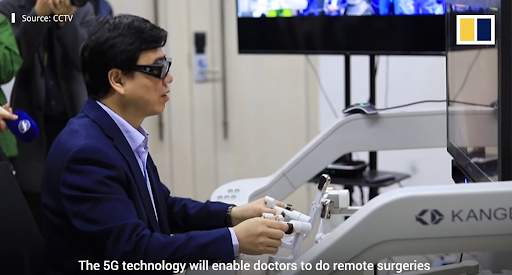Published on: Mar 10, 2023
Robotic surgery is a way of performing surgical procedures with the help of robotic systems. A surgeon, instead of directly using the required operating tool (e.g. scalpel), remotely makes use of devices that have hand-like movements and perform the procedures for him. These special robots, also called telemanipulators or remote manipulators, are robotic arms consisting of electronic, hydraulic, or mechanical components that allow movements from a remote location. The surgeon uses a control deck or a joystick-like controller to command a telemanipulator located in a remote hospital to perform surgery on a patient. An example is shown in Fig. 1.

Fig. 1: Example of command console and telemanipulator [5].
The first transatlantic operation was conducted in 2001 by surgeons in New York on a patient in France [1]. Since then, remote surgery has become much more common – for example, in 2014 a Canadian doctor operated on 20 patients located in different hospitals all over the country [1]. Remote surgery can offer several advantages: firstly, people can access better healthcare and higher quality medical care without traveling; secondly, compared to traditional surgery, it can provide more precise and steady movements, due to the use of 3D HD cameras and the mechanical precision of a robot. This results in smaller incisions, leading to reduced pain and faster recovery times for patients, as compared to traditional surgical operations which can be lengthy and are affected by surgeon fatigue [5].
As explained in [2], the critical requirements that must be guaranteed for successful remote surgeries are:
- Sustainable high-speed performance
- Minimum latency in milliseconds
- Reliable network connection during the whole operation
- Security of hardware and software
- Stable power grid/electricity supply
From a wireless telecommunication perspective, the first three points of the list are hard to achieve, however, attempts of remote surgery over 5G networks are already taking place [4]. For example, in China, a surgeon was able to complete a hepatic lobectomy on an animal located 50 km away. The wounds were neat and the vital signs of the animal were stable after surgery. The latency was 100 ms during the operation, which took around one hour. Remote surgeries need to be carried out over low-latency, high-speed networks, since human lives are at stake. So far, wired networks were preferred over wireless because the aforementioned requirements were fulfilled. However, having a dedicated and direct wired connection between the surgeon location and the location of the remotely accessible tool is not always feasible. A wireless solution would make it possible for the surgeons to control a remote machine located in any facility from any hospital. Reliable network infrastructures are fundamental for this use case and 5G can play an important role. Theoretically, 5G communication should reach speeds of 20 Gbps and latency of 1 ms [3], but in reality, the existing 5G networks are still far from achieving this targeted performance.

Fig. 2: Doctor performing a surgery over 5G network [6].
To conclude, the technology for remote surgery using 5G networks is still being developed and it will take more time before it can provide reliable and stable networks for prolonged operations. Even though 5G has the capability to support remote surgery, it is not yet fully mature and requires further research and development before it can be widely adopted for medical purposes. However, with the ongoing efforts in this field, it’s just a matter of time before it becomes a viable option for remote surgeries.
References
[1] https://www.bbc.com/future/article/20140516-i-operate-on-people-400km-away
[2] https://semiengineering.com/risks-rise-as-robotic-surgery-goes-mainstream/
[3] https://b5g-mints.eu/blog21/
[4] World’s First Remote Operation Using 5G Surgery
[5] https://www.flushinghospital.org/newsletter/facts-about-robotic-surgery/





